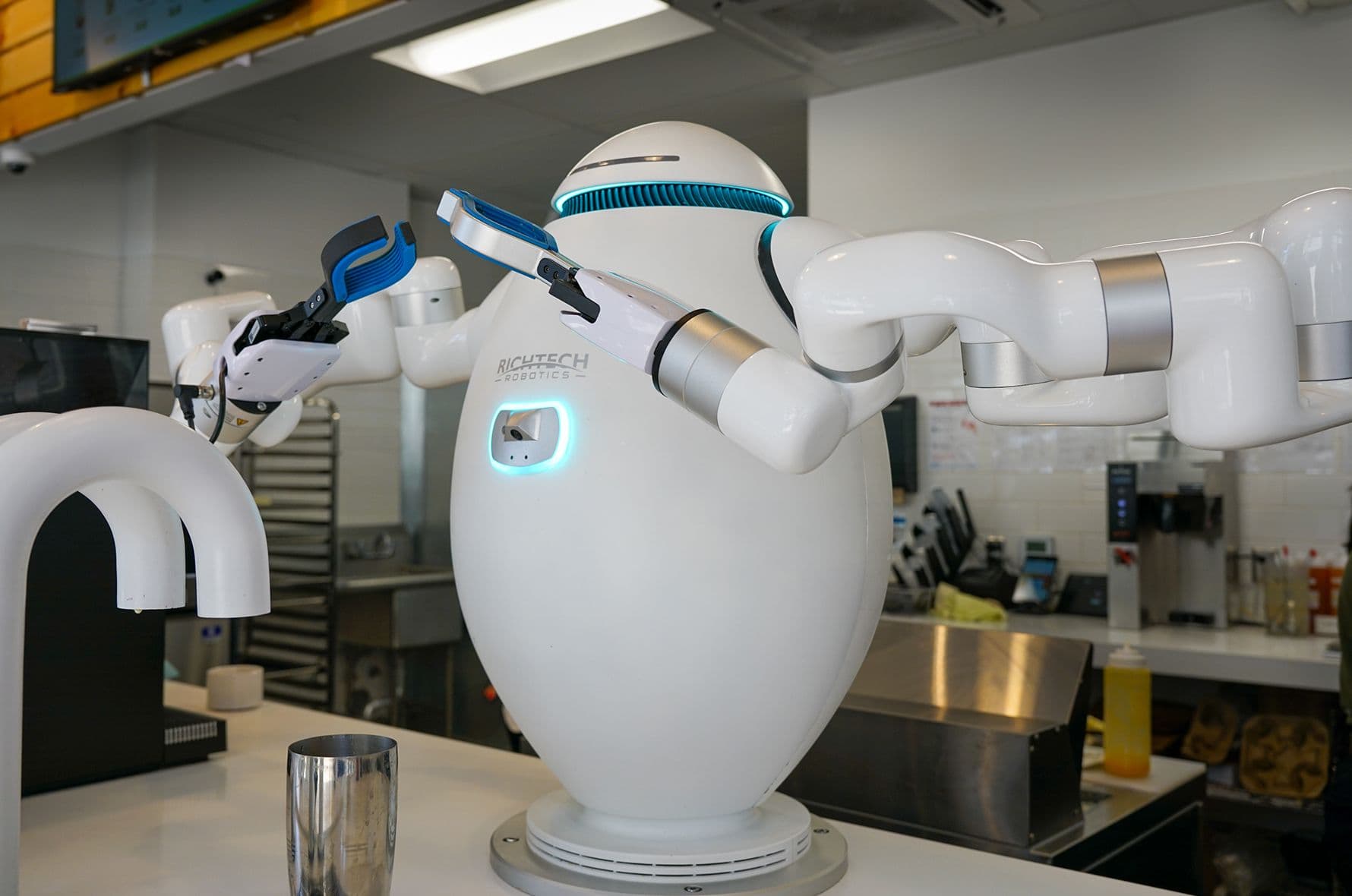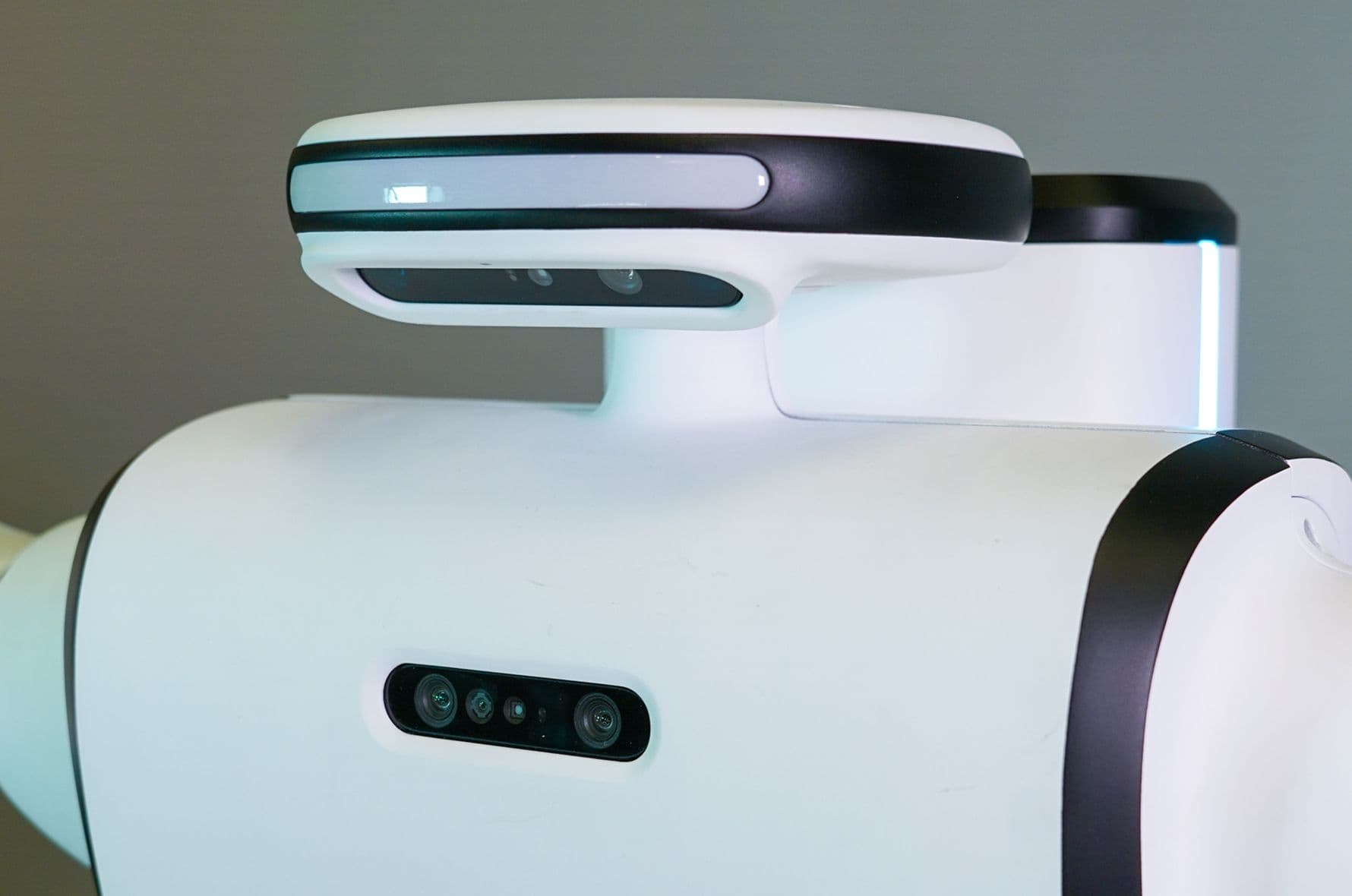Richtech's Human-Centric Design Philosophy: Why We Build Robots That Liberate, Not Replace

- Most robotics companies are solving the wrong problems. Richtech focuses on human liberation, not human imitation.
- Richtech’s design philosophy starts with people. Robots are built to complement, not compete with, human talent.
- Function over flash. Purpose-built robots outperform flashy humanoids in energy efficiency, safety, and cost.
- Affordable automation is a strategic advantage. Richtech democratizes robotics for small and mid-sized businesses.
- Specialization wins. Robots optimized for healthcare, restaurants, and retail create measurable ROI and industry transformation.
- Most robotics companies are solving the wrong problems. Richtech focuses on human liberation, not human imitation.
- Richtech’s design philosophy starts with people. Robots are built to complement, not compete with, human talent.
- Function over flash. Purpose-built robots outperform flashy humanoids in energy efficiency, safety, and cost.
- Affordable automation is a strategic advantage. Richtech democratizes robotics for small and mid-sized businesses.
- Specialization wins. Robots optimized for healthcare, restaurants, and retail create measurable ROI and industry transformation.
8-10 minute read time
Many robotics companies are building the wrong robots.
They're obsessed with creating mechanical humans when businesses need mechanical problem-solvers. It's like trying to cure hunger by inventing a fork that looks like a hand instead of making food more accessible.
That fundamental misunderstanding explains why we've deployed over 400 autonomous robots while our competitors struggle to move beyond viral TikTok videos and investor presentations that look spectacular on camera but crumble when encountering a wet floor or a confused customer.
Here's what nobody talks about at robotics conferences: the most successful robots don't look human at all.
When our CEO, Wayne Huang, talks about robotics design, he doesn't start with computational power or sensor arrays. He begins with a question that has nothing to do with silicon and everything to do with soul:
"How do we make humans more human?"
It's a question that sounds almost philosophical until you see it in action. Picture this: you walk into any restaurant using our robots and watch something remarkable happen. The human staff aren't huddled in corners plotting their exit strategies. They're absolutely thriving!
Chefs experiment with new dishes instead of letting their brains rot from repetitive tasks. Servers are building genuine customer relationships instead of running around high on energy drinks. Your people are actually growing the business instead of desperately trying to keep up with impossible physical demands.
This isn't automation. This is liberation.
And it's exactly the opposite of what every other robotics company is trying to build. It places greater emphasis on how robots should enter commercial spaces, which is what truly matters.
What would your workplace look like if your best people could focus exclusively on what only humans can do?
Why the Industry Got It Completely Backwards

Wayne's approach to robotics isn't just different—it's revolutionary.
While the industry burns through billions chasing robots that capture imagination (and Instagram likes), Wayne has spent over two decades developing "human-centric design principles."
Our ADAM robot has undoubtedly earned its share of spotlight moments, appearing on television and generating serious media coverage. Fun fact: ADAM is the most photogenic robot in the world! But here's what's fascinating about Wayne's patented creation (US Design Patent D1028047S): even our most camera-ready robot was designed first and foremost to solve real human problems.
These aren't feel-good marketing buzzwords. They're engineering mandates battle-tested across 400 real-world deployments where failure means lost revenue, not just lost likes.
Want to know why our robots succeed where others fail spectacularly? It all comes down to three simple principles that are frustratingly difficult to execute.
Most companies get stuck on step one. We've mastered all three.
Which principle do you think trips up most robotics companies?
Principle 1: Solve Real Problems (Not Engineer Fantasies)

Technology should eliminate actual pain, not create new problems.
This principle sounds so obvious it's almost insulting to mention, right? Yet you'd be shocked how many robotics companies get completely distracted by what's technically impressive rather than what's practically valuable.
They build robots that can do backflips, play chess, or dance Gangnam Style, then act genuinely surprised when businesses refuse to write checks.
Here's the brutal truth about impressive capabilities: They're exactly that. Impressive. But impressive doesn't pay rent or increase profit margins.
Last year, I watched a competitor's humanoid robot demonstrate its ability to recognize and sort colored blocks during a major trade show. The crowd was mesmerized! The engineering was undeniably sophisticated.
Afterward, I overheard a restaurant owner ask a simple question that nobody could answer: "That's cool, but how does this help me serve more customers during lunch rush?"
Silence.
The Questions That Matter
Wayne's approach cuts through the noise with laser focus:
- What dull work is slowly draining the creative soul out of your most talented employees?
- Which repetitive tasks make people question why they went to college?
- What hazardous jobs put your team at unnecessary risk for no good reason?
Our restaurant robots don't whip up molecular gastronomy or charm customers with witty conversation. They handle the mind-numbing logistics of carrying plates from Point A to Point B so your chef can focus on creating that signature sauce that keeps customers coming back.
Our healthcare robots don't diagnose rare diseases or perform delicate surgeries. They manage inventory, deliver supplies, and handle the endless logistics that consume too much of a nurse's valuable expertise.
Ever watch a highly trained medical professional spend an entire hour hunting down basic supplies? It's heartbreaking. And ridiculously expensive!
This isn't about replacing humans. It's about unleashing their potential.
What repetitive task in your industry wastes the most human talent?
Principle 2: Designing Robots to Work Seamlessly with Humans in Shared Spaces

The most advanced robot in the world is worthless if humans refuse to work with it.
Wayne discovered this truth through careful observation and some expensive lessons early in his career. I remember him telling me about watching factory workers systematically "malfunction" an advanced automation system they found threatening. Not through sabotage, but passive resistance that can kill any technology implementation.
Most robotics companies completely ignore this reality. They think humans will adapt if they build something technically impressive.
They're catastrophically wrong.
"Robot anxiety is real," Wayne explained during our recent interview. "People need to feel safe and comfortable around our technology, not intimidated or replaced by it."
The Design Elements That Work
This psychological insight completely revolutionized our approach:
Friendly, approachable forms that feel more like helpful appliances than threatening replacements
Predictable movement patterns that signal cooperation rather than competition
Crystal-clear communication through lights, sounds, and interfaces so people instinctively understand what's happening
The result? Our robots integrate seamlessly into existing workspaces without the friction and resistance that plague other implementations.
Walk into any of our 400 deployment sites and witness something beautiful: humans and robots working together with the natural flow of a well-rehearsed dance. No tension. No weird power dynamics. Just cooperative productivity that makes everyone's day significantly better.
How many other robotics companies can honestly say that?
Principle 3: Function Over Form (Even for the World's Most Photogenic Robot)
Here's where Wayne's philosophy gets genuinely controversial.

While competitors prioritize visual appeal and anthropomorphic design that looks great in demos, Wayne made a calculated choice: optimize for performance while maintaining approachable aesthetics.
Take ADAM, Wayne's patented masterpiece, and possibly the most photogenic robot in the world. This machine has enough screen presence to land television appearances and generate serious media buzz, but beneath that camera-ready exterior lies engineering specifically optimized for stationary operation excellence.
Wayne's response to design philosophy questions is thoughtful:
"We design robots that people want to work with and perform reliably in real-world conditions. Sometimes those goals align beautifully."
The Engineering Reality Nobody Talks About
Stationary units and wheeled platforms dominate in every metric that matters:
Energy efficiency: Our mobile robots operate up to 14 hours continuously. Complex locomotion systems? They're lucky to manage 2-4 hours.
Safety profile: Dramatically fewer collision incidents compared to alternatives with unpredictable movement patterns
Maintenance requirements: Simplified mechanical systems mean less downtime and fewer emergency repair calls at 3 AM
Deployment speed: Our units can be operational within hours, not the weeks of complex calibration some systems require
But here's the real breakthrough: optimized production costs make advanced automation accessible to small businesses.
Instead of selling million-dollar robots to wealthy Fortune 500 companies, we built solutions that deliver measurable savings for small and medium-sized businesses.
Suddenly, automation wasn't just for tech giants and manufacturing behemoths. It was for everyone.
What would happen to your industry if every small business could afford advanced automation?
The Specialization Strategy That Destroys "Do Everything" Robots

The robotics industry has this bizarre obsession with building "Swiss Army knife" robots.
Wayne saw this as a strategic error that would doom most competitors to expensive mediocrity.
"A robot designed to do everything will excel at nothing," he argues with the conviction of someone who's watched this principle play out across hundreds of deployments. "Specialization isn't a limitation. It's the secret weapon that wins markets."
Each of our robot models is purpose-built for specific industries:
Restaurant Robots: Navigate spaces so tight that humans constantly bump into each other, withstand kitchen chaos, and comply with food safety regulations
Healthcare Robots (Medbot): Meet HIPAA compliance from day one, feature gentle movements that won't alarm patients, include antimicrobial surfaces
Retail Robots: Handle inventory with accuracy that surpasses human capabilities, navigate crowded aisles during peak periods, and adapt to seasonal layout changes
This specialization creates what economists call a "compound advantage." Instead of being mediocre at twelve different tasks, our robots excel at the specific jobs they're designed to perform.
The Affordability Revolution That Changed Everything

"Affordability isn't negotiable," Wayne insists with the passion of someone who remembers what it's like being a small business owner. "If only large corporations can benefit from robotics, we've failed as technologists and innovators."
A family-owned restaurant can deploy our robot for less than the cost of a luxury pickup truck. An independent medical practice can automate supply management without requiring a second mortgage.
This accessibility strategy doesn't just expand our market; it also enhances our brand. It transforms entire industries by making automation economically viable for the businesses that need it most.
When was the last time you saw technology truly democratize an entire industry?
The Human Enablement Effect That Everyone Misses

Wayne's most profound insight? Automation should make humans more human, not less.
"Throughout history," Wayne observes, "automation has consistently shifted work toward higher-skill roles. Our solutions unlock human potential rather than eliminate it."
In restaurants: Chefs spend more time creating signature dishes and less on repetitive prep work.
In healthcare: Medical professionals focus on patient care while robots handle logistics.
In retail: Associates provide personalized customer service while robots manage stock monitoring.
The pattern repeats across every deployment: humans do what humans excel at, while robots handle what robots excel at.
It's not replacement. It's specialization. It's optimization. It's common sense applied to workplace design.
The Snowball Effect That's Becoming an Avalanche

Wayne's human-centric design principles aren't just philosophy. They're a business strategy that builds compounding advantages:
- Customer loyalty through superior user experience
- Operational efficiency through specialized, purpose-built designs
- Market expansion through affordability and accessibility
- Regulatory compliance through privacy-by-design architecture
- Human acceptance through thoughtful, approachable design
The result? 400 deployed robots and counting, with 1,000 targeted within the next 12 months.
But more importantly, we've proven that human-centric robotics isn't just an idealistic philosophy—it's a practical business strategy that works in the real world.
What This Means for Your Competitive Position
The companies already implementing our robots aren't just cutting labor costs; they're also improving productivity. They're creating entirely new operational models that competitors simply can't match without similar technology.
Early adopters redeploy human talent to high-value creative work that builds customer loyalty and brand differentiation. They're not replacing humans but amplifying human capabilities to create sustainable competitive advantages.
The question isn't whether automation will transform your industry. Whether you'll lead that transformation or scramble to catch up after your competitors have already gained an insurmountable advantage.
Which side of that equation do you want to be on?


